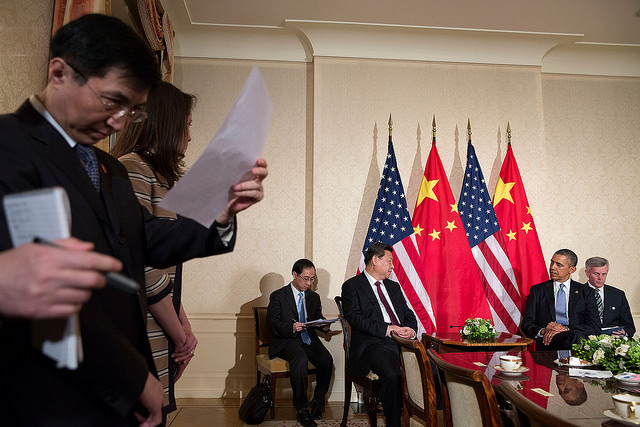 The biggest question facing Asia is becoming even starker because leaders are giving such different answers. The leaders of the US, China and Japan have just illustrated the conundrum that Rod Lyon outlined in his piece on Asia’s fraying order. Simply stated, the biggest question is: who rules? Or, in slightly expanded form, it asks: what is the Asian security system and how will it run?
The biggest question facing Asia is becoming even starker because leaders are giving such different answers. The leaders of the US, China and Japan have just illustrated the conundrum that Rod Lyon outlined in his piece on Asia’s fraying order. Simply stated, the biggest question is: who rules? Or, in slightly expanded form, it asks: what is the Asian security system and how will it run?
Mind you, Asia is lucky that it has graduated to the point where this is the major security quandary it faces. In recent memory, the problems were even bigger: will the new nations of Asia form and unite? Can Asia modernise and deliver a better life for its people?
Having climbed those huge mountains, a rich and powerful Asia can afford a naval arms race as part of this new power contest. Before donning the gloom-and-doom persona that strategists share with economists, it’s worth pausing to reflect that Asia’s new big question is the product of success. As China’s President remarks: ‘Asia today, though facing more risks and challenges, is still the most dynamic and promising region in the world. … Such a sound situation in the region has not come easily and ought to be doubly cherished’. Hear, hear!
After that unusual always-look-on-the-bright-side moment (well, unusual for The Strategist), let’s turn to the conflicting answer that leaders of Japan, China and the US are serving up to the big new conundrum.
As the previous post reported, Shinzo Abe agrees with the Chinese that Asia’s prosperity is shining and expanding, but Japan’s Prime Minister sees China as a threat to that status quo.
China, too, has laid out its views about how the system is shifting. Xi Jinping went directly to the systemic level (and who rules it) with his Shanghai security speech. The speech is here and is worth a read. You’ll find nothing in the text directly about high-sea dodgems, fighting fishing boats, coral confrontations, reef raids or roving oil rigs. But Xi’s fine words about how Asia’s new security system should work—and his proposal for new institutions—are valuable, if merely because the region can play them back to China, asking it to meet such standards.
Xi serves up much of what has become the usual Chinese boilerplate on Asia’s security system over the previous two decades, but adds in fresh strokes to be expected from a new leader starting to paint with confidence. The traditional frame is in place—that Asia needs new security thinking (Xi’s ‘new security concept’), not the old, Cold War security thinking. In that Chinese analysis, though, the US bilateral treaty system in Asia is the oldest of old thinking.
The jabs at old thinking are getting sharper. Thus, this whack from Xi: ‘To beef up and entrench a military alliance targeted at a third party is not conducive to maintaining common security’. That sets the scene for the widely-quoted Yankee-go-home call by Xi for an Asian system run by Asians:
In the final analysis, it’s for the people of Asia to run the affairs of Asia, solve the problems of Asia and uphold the security of Asia. The people of Asia have the capability and wisdom to achieve peace and stability in the region through enhanced cooperation.
The problem for Xi in offering Chinese leadership to that bright Asian future is he’s getting precious little Asian followship.
Across the Pacific, Barack Obama’s West Point speech looks like his Guam doctrine moment, offering balm to a war-weary America. Thankfully for Asia, Obama’s doctrinal moment has been far more carefully structured than Richard Nixon’s; unveiled at an impromptu press conference at a flight stopover in Guam on the way to Asia in the dog days of the Vietnam war. Even Kissinger was amazed that Nixon had publicly launched, in Guam of all places, their private ruminations on post-Vietnam strategy and the call for allies to do more of the heavy lifting.
Obama did his foreign policy big picture immediately after a four-nation tour of Asia that didn’t include China. And the promises he made in Asia must be weighed against the Asia-lite content of the speech. The fact of that Asia tour counsels against the fevered commentary that Obama has rebooted foreign policy by giving the boot to the Asia pivot. Even in a speech where Asia hardly figured, there was still room for three mentions of the South China Sea and a warning to China to play by the rules.
Going to Asia but not to China was both a nod and a jab at Beijing. The nod is that China’s now in a category of its own at the top of the mountain—the G2 perspective. Or as I put it last year when Obama and Xi met, render it as the g2, because both sides deny that they’d ever connive at condominium.
The jab is in the understanding—shown in the planning rather than the words—that China has become the default enemy in Asia.
Back to that big question: what is the Asian security system and how will it run?
Graeme Dobell is the ASPI journalist fellow. He is reporting from the 2014 Shangri-La Dialogue in Singapore. Image courtesy of Flickr user The White House.

